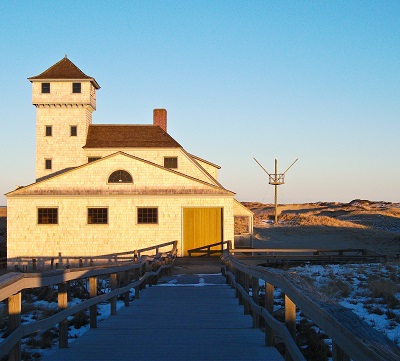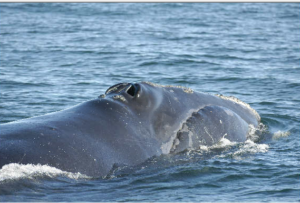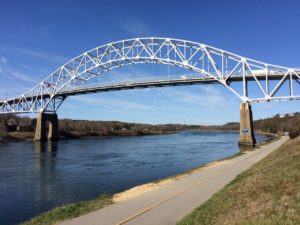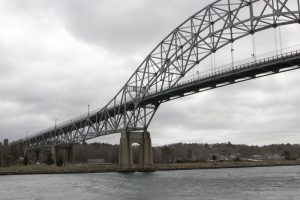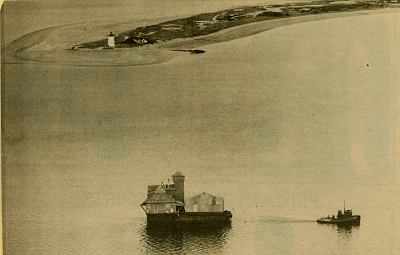
Old Harbor Station on a barge floating into Provincetown Harbor in 1977 courtesy of John Dowd, Althea Boxall Collection/Provincetown History Project Archives
Cape Cod and the sea are forever intertwined. Being surrounded by the ocean has meant that the landscape of the area has been dotted with lighthouses to protect those vessels passing along the shores. However sometimes the safety precautions are not enough and countless shipwrecks have happened all throughout the Cape’s history. In the time before the United States Coast Guard was the modern rescue team that it is today there was another organization who was in charge of maritime rescue. The United States Live-Saving Service was established in 1848 and to assist them in their aid to distressed vessels there would be life-saving stations built along the shore. Originally nine such stations were built on the Cape in 1872 with that number eventually reaching thirteen, laid out in three-to-five mile increments along the coast in areas including Nauset Beach, Cahoon Hollow Beach in Wellfleet, Race Point in Provincetown, and Monomoy Point in Chatham.
In 1897 the Old Harbor Life-Saving Station was built in Chatham on North Beach just south of the Chatham Twin Lighthouses. It was built in that location due to the loss of the Calvin B. Orcutt, a three-masted schooner, in December 1896. The vessel went down with all of her crew and was the only wreck recorded along that section of the Chatham shore. It would be built in what became known as the ‘Duluth Style’ due to its unique layout designed by George Tolman, a US Life-Saving Service architect. In all his design would be used to create twenty-eight stations which included a rectangular lookout tower giving the buildings a unusual look. The nine-room, two-story station would be captained by Hezekiah Doane who had been reassigned there from the Chatham Coast Guard station and would remain in place until 1915.
The station would see some improvements to help accommodate changes to lifeboats in 1910. Though not as busy as some of the other Cape life-saving stations Old Harbor would see its share of action including the rescue of Joseph Dutra and Manuel Silva in their overturned dory just off shore in May 1912, and the rescue of the crew of eight men from the schooner Future in May 1914. The next year in 1915 the United States Life-Saving Service was absorbed into the Coast Guard.
Over time the life-saving stations of Cape Cod would become obsolete as the Coast Guard performed all of the same rescue duties. In the 1940’s the life-saving stations of the original 1872 ilk would be sold or razed. In fact only one of the original stations remains at the location where it was built, the Cahoon Hollow Station in Wellfleet which today operates as The Beachcomber. However the story of the Old Harbor Station had only begun.
The venerable station would be decommissioned and abandoned in 1947. It would remain that way until 1957 when the federal government would sell the property to Mr. G. Bearse who would turn and sell it to Howard Rose who would use it as a private residence. In the mid-1970’s the National Park Service would buy the building, though Rose had an occupancy permit which lasted until April 1978.
After its purchase the Old Harbor Life-Saving Station was nominated to be added to the Register of Historic Places in 1975. This opened up federal funds for its preservation. Before this the building was at the mercy of the encroaching Atlantic Ocean on North Beach. In Chatham at the time some felt the building should be moved to a safer inland area due to the fact that at times it sat roughly ten feet from the water. Others, decrying its relative inaccessibility, said money should be spent elsewhere. One radical idea was for the building to be taken down and floated up the coast to the dunes of Race Point in Provincetown.
The debate raged on until events pushed a decision to the forefront. In October 1977 a huge Nor’easter pummeled the Cape and the storm surge brought the ocean’s waves right up to the foundation of the Old Harbor Station. In November the National Park Service decided to spend more than $100,000 to lift the building from its spot on North Beach and float it thirty-six miles up the coast to Race Point. The building was cut in two and lifted onto a barge November 29th and was floated up to Provincetown in one day. The move came in the nick of time as only two months later the landmark Blizzard of ‘78 hit the Cape and likely would have destroyed the station.
Ironically the historic storm did affect the Old Harbor Station. The building had remained on the barge in Provincetown Harbor for months due to a poorly made foundation at Race Point, bad weather conditions, and the fact that the cranes which removed it in Chatham had taken longer than expected to reach Provincetown. The barge sustained some damage during the Blizzard of ‘78 but hung on. Finally in May 1978, more than five months after leaving Chatham, the Old Harbor Station touched down in the dunes of Race Point, 400-feet east of the beach parking lot.
After a year of renovations the building would open to the public in May 1979 as the Old Harbor Life-Saving Museum. Lastly a boardwalk for easier access over the dunes would be added in the summer of 1985.
Safely nestled among the dunes at Race Point, the Old Harbor Life-Saving Station will serve as a link to an important slice of Cape Cod’s past for many years to come.
By Christopher Setterlund





